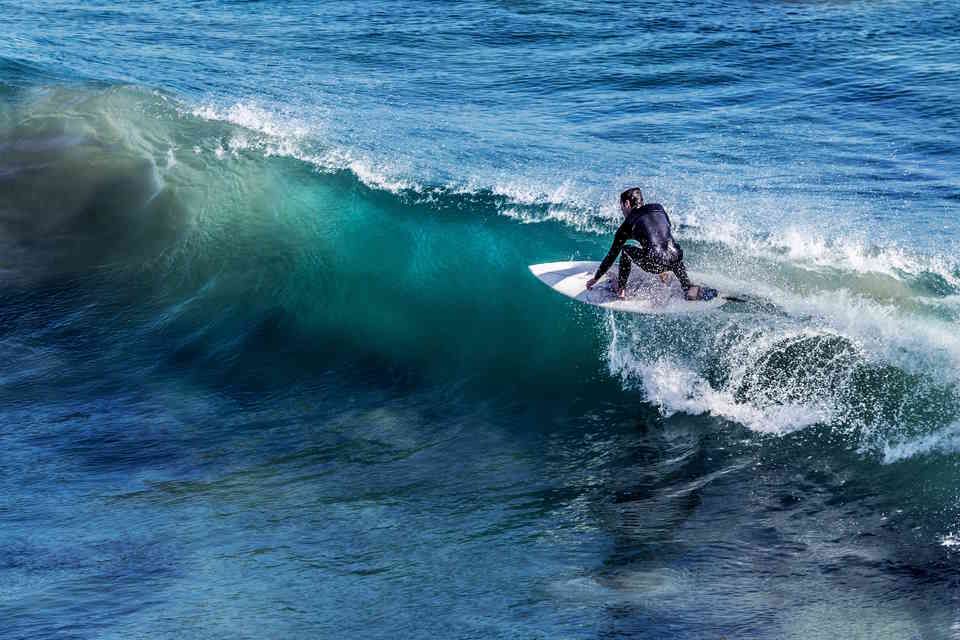If you’re planning to hit the waves and try surfing for the first time, it’s important to know what to wear. While it may seem like all you need is a swimsuit and a surfboard, there are actually a few key things to consider when it comes to your surfing attire. We’ll cover the essentials, including what to wear, what not to wear, and whether or not you need a swimsuit for surfing. Whether you’re a beginner or an experienced surfer, read on to learn more about how to dress for success on the waves.
Introduction

Surfing is an amazing sport that requires both skill and appropriate attire. Wearing the right clothing can make a big difference in your surfing experience. When surfing, you need to wear clothing that allows for a full range of motion, protects you from the sun, and dries quickly. Here are some tips on what to wear to surfing:
- Wetsuits: Wetsuits are the most common clothing item worn while surfing. They provide warmth, buoyancy, and protection from the rough surf. It is important to choose a wetsuit that fits snugly but is not too tight. A wetsuit that is too loose will fill with water, making it heavy and uncomfortable to wear.
- Rashguards: Rashguards are another popular clothing item worn while surfing. They provide protection from the sun, prevent rashes from rubbing against the board, and help wick water away from the skin. Rashguards come in different styles and materials such as neoprene, lycra, and spandex. Choose a rashguard that fits well and is comfortable to wear.
- Board shorts: Board shorts are designed specifically for surfing. They are made of quick-drying, lightweight material and have a longer inseam to provide more coverage. Board shorts are available in a variety of colors and patterns to suit your style and preference. Choose board shorts that fit well and are comfortable to wear.

To protect your feet while surfing, you can wear either water shoes or surf booties. Water shoes are lightweight and made of materials that dry quickly. Surf booties are made of neoprene and provide more insulation than water shoes. Both options provide traction and protection from rocks and other sharp objects in the water.
When surfing, it’s important to avoid wearing items that can get caught on the board such as jewelry, loose clothing, and hair accessories. Additionally, avoid wearing cotton clothing as it can become heavy and uncomfortable when wet. Instead, choose clothing made of synthetic materials that dry quickly and provide protection from the sun.
| Do wear | Don’t wear |
|---|---|
| Wetsuits | Jewelry |
| Rashguards | Loose clothing |
| Board shorts | Hair accessories |
| Water shoes | Cotton clothing |
| Surf booties |
Do You Need a Swimsuit for Surfing?

Surfing is one of the most popular water sports in the world and is enjoyed by people of all ages. It is a thrilling and adventurous experience to ride the waves, but many beginners wonder whether they need to wear a swimsuit while surfing or not. The answer to this question depends on a number of factors. We will discuss the importance of wearing a swimsuit while surfing and also look at some other clothing options.
Firstly, it is important to understand that surfing involves a lot of physical activity and movement, which means that loose clothing or anything that restricts your movement should be avoided. This is why a swimsuit is the most appropriate clothing option for surfing. It allows you to move freely and ensures that you are comfortable while riding the waves.
- Swimsuits are designed to stay in place even when you are being tossed around by the waves, which means that you don’t have to worry about your clothing slipping or falling off.
- A swimsuit is also made of material that dries quickly, which is important because you will be spending a lot of time in the water.
However, if you don’t own a swimsuit or prefer not to wear one, there are a few other clothing options that you can consider. One option is to wear board shorts or a wetsuit. Board shorts are designed to stay in place and dry quickly, and they are popular among both male and female surfers. Wetsuits, on the other hand, are designed to keep you warm in colder water temperatures and also protect your skin from the sun and any scrapes or cuts.

| Pros of Swimsuits | Pros of Board Shorts and Wetsuits |
|---|---|
| Designed for movement and comfort | Available in a variety of styles and designs |
| Dries quickly | Provide warmth and sun protection |
| Stays in place while surfing | Can be worn by both male and female surfers |
However, it is important to note that whatever clothing option you choose, it should not be too loose or have any sharp or pointed accessories that can be dangerous while surfing. Avoid wearing jewelry, watches or any accessories that could get caught on something in the water. Also, avoid wearing cotton clothing as it can become heavy when wet and make it difficult for you to move.
What Should I Wear to My First Surfing Lesson?

If you’re planning to attend your first surfing lesson, it’s essential to dress appropriately. Not only will you want to feel comfortable, but you’ll also want to make sure your attire doesn’t hinder your progress. Let’s take a look at what you should wear to your first surfing lesson.
- Swimsuit: A swimsuit is a must-have item for beginner surfers. Opt for a one-piece swimsuit or a rash guard and board shorts. Avoid wearing bikinis or loose-fitting swimwear, as they can easily shift around. Make sure your swimsuit is comfortable and well-fitted, so you can move freely.
- Rash Guard: A rash guard is a tight-fitting shirt designed to protect your skin from chafing. They’re perfect for surfing because they won’t restrict your movement, and they protect your skin from the sun and board wax. You can wear a rash guard on its own or under a wetsuit.
- Wetsuit: If the water is chilly, you may want to wear a wetsuit. Wetsuits are made of neoprene and provide insulation to keep your body warm. They’re available in various thicknesses, so choose the one that is appropriate for the water temperature.
- Sunscreen: Don’t forget to apply sunscreen regularly, especially if you’re surfing during the day. Choose a waterproof, broad-spectrum sunscreen with an SPF of 30 or higher. Apply it 15 minutes before entering the water and reapply every two hours.

| What to Wear | What Not to Wear |
|---|---|
| One-piece swimsuit | Bikinis or loose-fitting swimsuits |
| Rash guard and board shorts | Cotton clothing that absorbs water |
| Wetsuit (if needed) | Denim shorts or pants |
| Waterproof sunscreen | Jewelry or anything that can get caught on the board |
Remember, surfing is a physically demanding sport, so wear clothes that won’t restrict your movement or weigh you down. Avoid wearing cotton clothing, as it will become heavy when wet and hinder your performance. Also, leave your jewelry at home, as it can get caught on the board and cause injury. By dressing appropriately, you can enjoy your first surfing lesson to the fullest.
Can You Wear Water Shoes Surfing?

Surfing is an enjoyable and thrilling experience that requires the right clothing and gear for safety and comfort on the waves. While the common apparel options include swim trunks or wetsuits, a question that often comes up is whether water shoes can be worn for surfing. The answer is not a straightforward yes or no, as it depends on several factors that we’ll explore.
Material and Design
If you’re considering wearing water shoes for surfing, the first thing to check is whether they’re made of materials that can withstand the ocean’s conditions. Water shoes that are designed for swimming or snorkeling may not be durable or stable enough for surfing. They may also not offer enough protection against rocks, shells, or other sharp objects that may be in the water or on the shore. In general, water shoes that are made of neoprene, a synthetic rubber, or a combination of rubber, mesh, and other materials can be suitable for surfing. Look for shoes that have a firm sole, a secure fit, and a snug ankle cuff that prevents them from slipping off.

Surfing Conditions
The decision of whether to wear water shoes for surfing also depends on the specific conditions of the waves, such as their height, temperature, and debris content. For instance, if you’re going surfing in a spot that has a sandy bottom and no rocks or shells, water shoes may not be necessary or may even hinder your performance. However, if you’re surfing in an area that has a reef, rocks, or a cold climate, water shoes can provide thermal insulation and protection. They can also help improve your grip and balance on a slippery board. Ultimately, it’s best to evaluate the water conditions and use your own judgment to decide whether water shoes are appropriate or not.
Surfing Style and Goals
The third factor to consider when thinking about wearing water shoes for surfing is your own surfing style or goals. If you’re a beginner or intermediate surfer who is still learning how to balance and maneuver on the board, wearing water shoes may give you more confidence and stability. They may also reduce the risk of injuries or cuts from the board or the water. On the other hand, if you’re an advanced or expert surfer who seeks speed, power, and radical moves, water shoes may not be the best choice. They could hinder your agility and limit your control over the board. In this case, you may want to stick to bare feet or surf booties that offer more flexibility and sensitivity.
What Should You Not Wear While Surfing?

When it comes to surfing, there are some clothing items that you should avoid wearing while hitting the waves. One of the most important things is to not wear clothes that restrict your movement. Clothing that is too tight or too loose can cause discomfort and hinder your ability to paddle, balance or stand up on your board.
Another thing to avoid is cotton clothing. Cotton becomes heavy when it gets wet, and can cause a drag that makes it difficult to move around in the water. Instead, opt for synthetic materials that dry quickly, such as nylon or spandex. Not only will these fabrics be more comfortable in the water, they will also prevent rashes and chafing.
- Avoid wearing jewelry when surfing as it can easily get damaged or lost in the water. This includes necklaces, bracelets and earrings.
- It is also not recommended to wear sunglasses while surfing because they can easily get knocked off by a wave or cause distractions when trying to focus on the waves.
- In addition, it is important to avoid wearing anything that can cause harm to yourself or other surfers.
Finally, it is always best to dress appropriately for the weather conditions. Wearing too much or too little clothing can cause discomfort and affect your performance in the water. Always check the weather forecast before heading out to surf and dress accordingly, including wearing a wetsuit if needed.

| Dos | Don’ts |
|---|---|
| Wear synthetic materials such as nylon or spandex for comfort in water. | Avoid cotton clothing, as it can become heavy and cause drag in the water. |
| Dress appropriately for weather conditions, including wearing a wetsuit when necessary. | Avoid wearing anything that can cause harm to yourself or other surfers. |
| Wear appropriate footwear, such as surf booties. | Wear jewelry or sunglasses while surfing which can easily get lost or damaged in the water. |
By being mindful of what you wear while surfing, you can ensure a comfortable and enjoyable experience while out on the waves. Remember, always prioritize safety and comfort over fashion when in the water!




